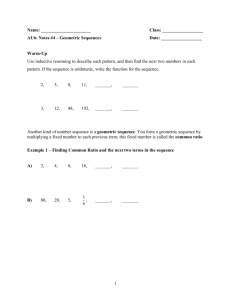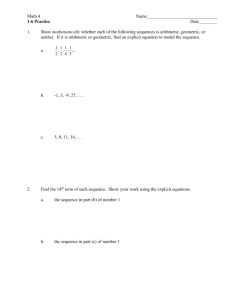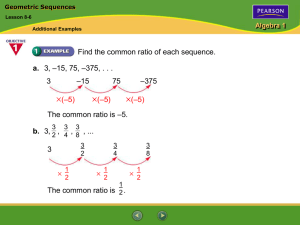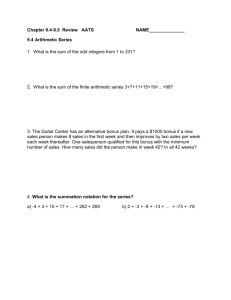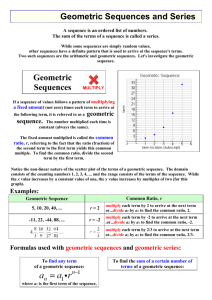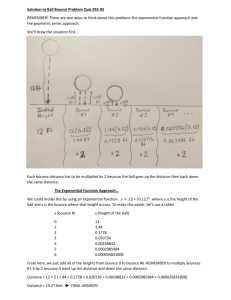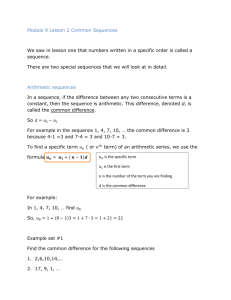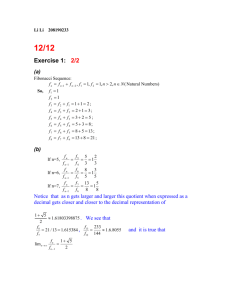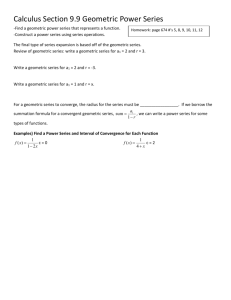7.5 Notes (Completed) - Fort Thomas Independent Schools
advertisement
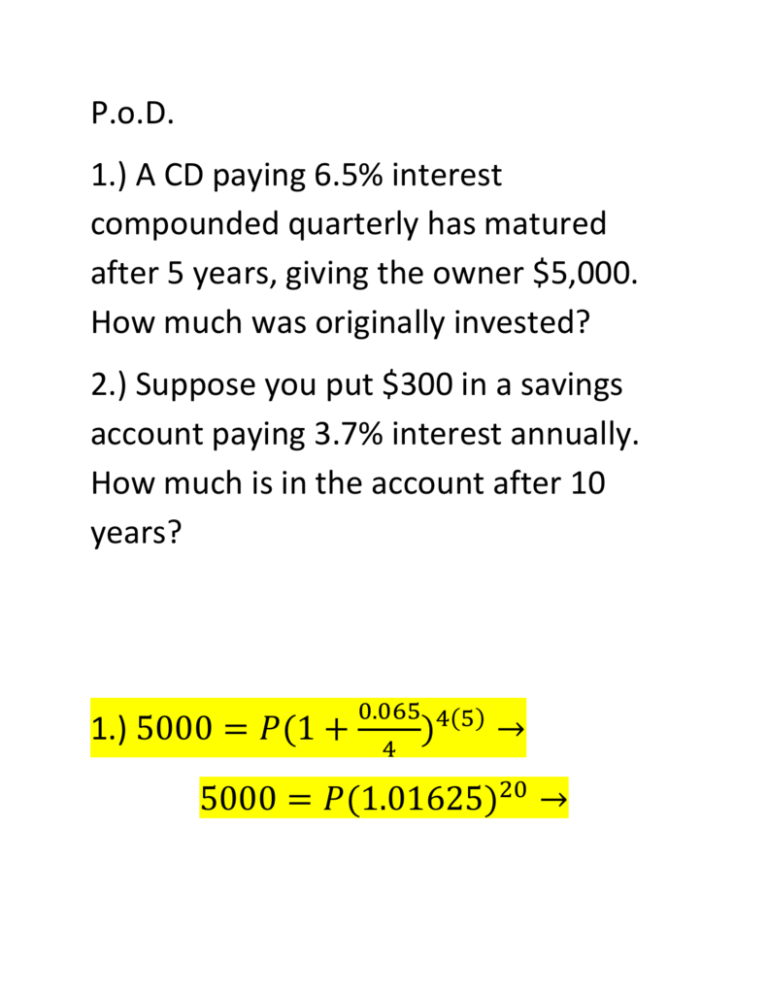
P.o.D.
1.) A CD paying 6.5% interest
compounded quarterly has matured
after 5 years, giving the owner $5,000.
How much was originally invested?
2.) Suppose you put $300 in a savings
account paying 3.7% interest annually.
How much is in the account after 10
years?
1.) 5000 = 𝑃(1 +
0.065 4(5)
)
4
→
5000 = 𝑃(1.01625)20 →
5000
= 𝑃 → $3622.09
20
1.01625
2.) 𝐴 = 300(1 +
0.037 1(10)
)
1
=
300(1.037)10 = $431.43
7-5: Geometric Sequences
Learning Target: I will be able to describe
geometric sequences explicitly and
recursively.
Let’s Review: The following sequences
are arithmetic:
1, 3, 5, 7, …
10, 12, 14, 16, …
0, -3, -6, -9, …
In an arithmetic sequence, each term is
found by adding a common difference to
the previous term.
In a Geometric Sequence, each term is
found by multiplying the previous term
by a constant ratio.
Examples:
2, 4, 8, 16, …
20, 10, 5, 5/2, …
5, 25, 125, …
Recursive Formula for a Geometric
Sequence:
𝑔1 = 𝑥
{𝑔 = 𝑟 ∙ 𝑔
𝑛
𝑛−1
EX: Give the first four terms of the
𝑔1 = 3
geometric sequence {
𝑔𝑛 = −3𝑔𝑛−1
3, -9, 27, -81
EX: Give the first six terms of the
𝑔1 = 5
geometric sequence {
𝑔𝑛 = 4𝑔𝑛−1
5, 20, 80, 320, 1280, 5120
Explicit Formula for a Geometric
Sequence:
𝑔𝑛 = 𝑔1 (𝑟)𝑛−1
EX: Write the 2nd, 5th, 12th, and 50th
terms of the sequence defined by 𝑎𝑛 =
4(−3)𝑛−1
𝑎2 = 4(−3)2−1 = 4(−3)1 = −12
𝑎5 = 4(−3)5−1 = 4(−3)4 = 4(81)
= 324
𝑎12 = 4(−3)12−1 = 4(−3)11
= 4(−177147) = −708588
𝑎50 = 4(−3)50−1 = 4(−3)49
= 4(−2.39299329 × 1023 )
= −9.57197317 × 1023
Have three students come to the board
to find the 1st, 5th, and 20th terms of the
sequence a is defined by
𝑎𝑛 = 3(−2)𝑛−1
𝑎1 = 3(−2)1−1 = 3(−2)0 = 3(1) = 3
𝑎5 = 3(−2)5−1 = 3(−2)4 = 3(16)
= 48
𝑎20 = 3(−2)20−1 = 3(−2)19
= 3(−524288) = −1572864
*Let’s write a calculator program for
geometric sequences.
EX: Suppose a ball is dropped from a
height of 12 feet and bounces up to 90%
of its previous height after each bounce.
(A bounce is counted when the ball hits
the ground). Let h be the maximum
height of the ball after the nth bounce.
The ball reaches a height of
12(.90)=10.8ft after the first bounce.
This is our initial value.
Find an explicit formula for ℎ𝑛 .
ℎ𝑛 = ℎ1 (𝑟)𝑛−1 = 10.8(.9)𝑛−1
Find the maximum height of the ball
after the 6th bounce.
ℎ6 = 10.8(.9)6−1 = 6.38𝑓𝑡
Sierpinski Triangle
http://www.youtube.com/watch?v=r4eFtUvgzfM
Upon completion of this lesson, you
should be able to:
1. Find a term in a geometric
sequence.
2. Identify applications of geometric
sequences.
For more information, visit
http://www.regentsprep.org/Regents/math/algtrig/ATP2
/GeoSeq.htm
HW. Pg.482
2-18, 20-23
